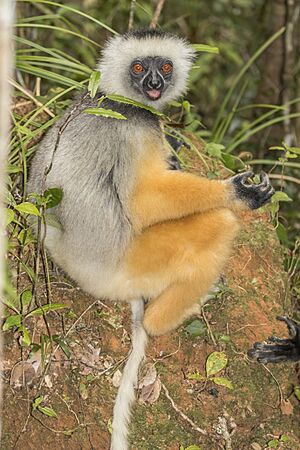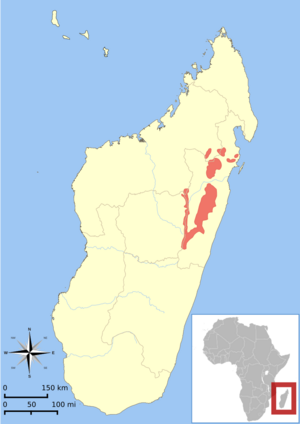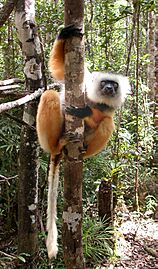Diademed sifaka facts for kids
Quick facts for kids Diademed sifaka |
|
|---|---|
 |
|
| in Analamazaotra Special Reserve | |
| Conservation status | |
| Scientific classification | |
 |
|
| Distribution of P. diadema | |
| Synonyms | |
|
The diademed sifaka (Propithecus diadema) is a special type of lemur found only in the rainforests of eastern Madagascar. It is also called the diademed simpona. This amazing animal is one of the largest living lemurs, weighing about 6.5 kilograms (14 pounds). It can grow to be about 105 centimeters (41 inches) long, with half of that length being its tail!
Many experts, like Russell Mittermeier, say the diademed sifaka is one of the most beautiful lemurs. It has a long, silky coat that makes it stand out. In the Malagasy language, people call it simpona, simpony, or ankomba joby.
Contents
What Does a Diademed Sifaka Look Like?
The diademed sifaka is easy to spot because of its unique colors and large size. Its fur is long, silky, and very soft. It has a ring of white fur around its face, covering its cheeks, forehead, and chin. This white fur looks like a "diadem" or crown, which is how it got its name.
Its eyes are a reddish-brown color, and its face is bare, ranging from dark gray to black. The fur on its crown is black and often extends to the back of its neck. The fur on its upper back and shoulders is grayish, while its lower back is lighter, almost silvery. Its sides and tail are a pale gray, sometimes even white. The fur on its belly is also white.
The sifaka's hands and feet are completely black. Its arms, legs, and the base of its tail are a yellowish-golden color. Only male sifakas have a large reddish-brown gland on the center of their throat.
Where Do Diademed Sifakas Live?
The diademed sifaka lives in many parts of eastern Madagascar. They can be found in lowland forests, from about 200 to 800 meters (656 to 2,624 feet) above sea level. They also live in mountain forests, from 800 to 1,550 meters (2,624 to 5,084 feet) high. These forest areas are very important for nature and are protected.
Their home range stretches from the Mananara River in the north to the Onive and Mongoro Rivers in the south. Like all lemurs, this species developed only on the island of Madagascar.
Scientists have found a small group of diademed sifakas in south-central Madagascar that look a bit different. Some of them are even all black! For now, scientists still classify them as diademed sifakas.
You can see diademed sifakas in places like Mantadia National Park, which is about a three-hour drive from Madagascar's capital city, Antananarivo. They also live in the forests of Tsinjoarivo.
How Do Diademed Sifakas Behave?
Diademed sifakas live in groups, usually with two to ten members. These groups can include several adult males and females. Each group has its own territory, which is about 25 to 50 hectares (62 to 125 acres) in size. They mark their territory using special scents from glands to warn other sifakas to stay away.
Even though they protect their territory from other sifakas, they often share it with other lemur species, like the red-bellied lemur and the common brown lemur. Diademed sifakas travel far each day, often more than 1.6 kilometers (one mile), looking for food.
They eat a lot of different plants, sometimes more than 25 different kinds in a single day! They eat fruits, flowers, seeds, and leaves, changing their diet depending on the season. They are active during the day.
These large lemurs are very athletic. They can jump sideways through the air at speeds up to 30 kilometers per hour (18 miles per hour). They push off vertical tree trunks with their strong legs. Diademed sifakas spend almost all their time in trees. They are known for clinging to trees and leaping from one to another.
If a predator on the ground is nearby, like a fossa or a Nile crocodile, the diademed sifaka makes a warning call that sounds like a "kiss-sneeze."
Female sifakas become ready to have babies when they are two or three years old, while males mature a bit later. Not much is known about their mating habits, but females are believed to be ready to mate only a few days each year. The female is dominant in the group and usually chooses her mate. Mating happens in the summer (around December), and a female usually has one baby per year.
Why Are Diademed Sifakas Endangered?
The diademed sifaka is listed as critically endangered on the IUCN Red List. This means they are at a very high risk of disappearing forever. In 2002, scientists estimated there were only about 6,000 to 10,000 of these sifakas left.
The biggest threat to diademed sifakas is the loss of their home, the forest. Local people often cut down trees to create farmland, a practice called "shifting cultivation." This problem happens even inside national parks because these areas are far from the government, making it hard to enforce laws that protect the sifakas' habitat.
As the population grows in central and eastern Madagascar, many poor people need land to survive. They clear forest lands using "slash-and-burn" methods to grow crops or get charcoal, firewood, or grass for their animals like zebu. This destroys the sifakas' homes.
How Are Diademed Sifakas Classified?
The diademed sifaka belongs to a group of four sifaka species within the Propithecus genus. The other three species are Milne-Edwards' sifaka (Propithecus edwardsi), Perrier's sifaka (P. perrieri), and the silky sifaka (P. candidus).
All these sifaka species have beautiful, silky coats and are powerful jumpers. They share many traits, like how long they are pregnant (four months), when they become adults, how females are dominant, and how long they live (about 18 years). They also like to sunbathe by stretching out on a branch. They look different in color, but all of them have completely black faces.






